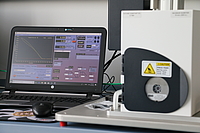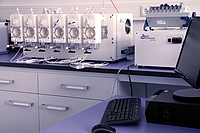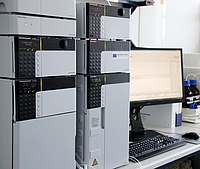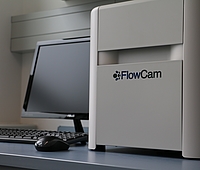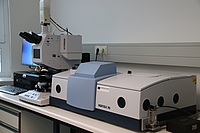EU Funding
ReLumen - Joint research project between Industry and Science in Mecklenburg-Vorpommern
Term: 2022-2027
A highly biocompatible covered stent is being developed within the joint project. The focus is on covered stents for use in emergency situations with coronary vessel perforations, as well as on the provision of optimized covered stents for peripheral indications. Innovative methods are being developed to process suitable biomaterials and to analyze the materials with regard to biocompatibility, mechanical properties and suitability for use.
Card-ii-Omics: Cardiovascular implant development – Infections – Proteomics: Prevention, diagnostics and therapy of Implant infections
Term: 2017 - 2021
The interdisciplinary research combination with partners at the University medicines and the universities at Rostock and Greifswald as well as with the Institute for Implant technology and Biomaterials e.V. in Warnemünde is funded within the excellence research program of Mecklenburg-Vorpommern.
The goal is to avoid infections of cardiovascular implants by biofunctionalisation and to improve the diagnosis and therapy of these life-threatening complications.
NovaCard - Joint research project between Industry and Science in Mecklenburg-Vorpommern
Project duration: 2017-2021
The joint project aims at the development of key technologies for the production of innovative biological heart valve prostheses. The project consortium is focused on novel processing technologies for heart valve materials as well as on innovative mechanical, biological and chemical test procedures. The joint project provides fundamental work towards the development of a new generation of durable transcatheter heart valve prostheses.
TheraMagna – Joint research between Industry and Science in Mecklenburg-Vorpommern
Term: 2016 - 2023
Within the joint research project for development of a new generation of bioabsorbable coronary vessel scaffolds, the focus is on the development of innovative polymer/active component coverings, its physico-chemical characterisation, considering the changing drug release behavior and the mechanical properties as well as contributions for development of manufacturing technologies for vessel scaffolds.
TheraVista – Joint research between Industry and Science in Mecklenburg-Vorpommern
Term: 2015 - 2020
Scientific goals of the joint research project are developments for technology, materials and processes, as a basis for new therapy platforms for vascular intervention.
![[Translate to English:] 3D-Smart-Milling](/fileadmin/_processed_/5/c/csm_3D_Smart_Milling_31636749fe.jpg)
3D Smart CNC Milling Router
Year of installation: 2021
The 3D Smart CNC Milling System provides high precision manufacturing of 2D and 3D parts and small series. This milling systems enables the manufacturing of complex geometries and free-form shapes. Due to the research focus and the resulting application in prototype manufacturing in the field of implant technology and special equipment construction, e.g. test bench setups, free-form shapes can be derived from anatomical geometries, for example. Computer aided design and computer aided manufacturing link the construction process directly to the subsequent manufacturing process. Various polymers (e.g. PMMA, PEEK, PVC) as well as metals and metal alloys (e.g. aluminum, brass, copper and stainless steels) can be machined.
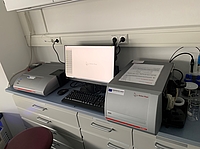
Measurement environment for determining the zeta potential and the size of particles
Year of installation: 2021
The measurement environment for determining the zeta potential and the size of particles in the range of few nanometers to micrometers enables the detailed characterization of particles and polymer surfaces in terms of surface charge and potential. The obtained results can be used to draw conclusions about the implant-tissue interaction of future implants and to optimize processing technologies. It is possible to determine the particle size and zeta potential in aqueous and organic solutions and suspensions. In addition, the measurement environment allows the determination of the zeta potential of liquid, powdery as well as solid (polymer) surfaces.
Thermogravimetric analysis (TGA/DSC 3+)
Year of installation: 2021
Thermogravimetric analysis or thermal gravimetric analysis (TGA) is a method of thermal analysis in which the mass of a sample is measured over time as the temperature changes. The TGA/DSC 3+ provides simultaneous thermogravimetric analysis and heat flow measurement. The aim of the analysis is, for example, to determine the residual solvent content in implant materials and coatings. Furthermore, in addition to the thermal material properties, the TGA/DSC 3+ also enables information on post-treatment by chemical and physical methods for the specific adjustment of physico-chemical properties and their verification. The device is equipped with an ultra-microbalance capable of a resolution of 0.1 µg. The integrated sample changer minimizes the risk of contact with crucibles and chemicals and thus also enables larger sample quantities to be performed as part of quality assurance.
Tensiometer with contact angle measuring device
Year of installation: 2021
The combination of a contact angle measuring device and tensiometer allows the investigation of complex structures such as drug-loaded nanoparticles, micro/nanofiber nonwovens and thin-film coatings in a wide range of media under application conditions. Wettability, adhesion and swelling of the drug-polymer coatings on implant structures can be investigated. The extensive equipment allows characterization of surface and interfacial tensions of solid, powdery and liquid substance mixtures. In addition, statements can be made on the surface quality of subsequent chemical or physical modifications, which are used to selectively adjust the surface chemistry. The assessment of the absence of defects, porosity, interaction and swelling of thin-film and nonwoven coatings of future implants is crucial in order to make selective process adjustments. For example, testing the solution and environmental conditions during the coating processes.
Gel permeation chromatography (GPC) system
Year of installation: 2020
The gel permeation chromatography (GPC) system is used to characterize polymers with respect to their molecular weight. The focus of the system is on water-soluble substances. In addition to synthetic polymers and hydrogels, the molecular weight of biomolecules such as carbohydrates and proteins can also be determined. From the knowledge of the molecular weight, conclusions can be drawn about biomechanical properties and processing of the materials. Furthermore, degradation studies can be used to describe their degradation behavior. The core component of the system is the light scattering detector, which in combination with the refractive index detector makes it possible to measure absolute molar masses. The light scattering detector is equipped with 8 measuring angles, which allows the determination of the hydrodynamic radii of macromolecules and particles in solution.
Pulse duplicator system / Heart valve durability tester
Year of installation: 2020
For hydrodynamic characterization of prosthetic heart valves cardiovascular hydrodynamic test systems mimicking conditions of the left side of a heart are used. These pulse duplicator systems technically simulate the function of the left heart and have been established for years to characterize heart valve prostheses under simulated cardiac conditions. The new generation testing device will be applied to analyze heart valve prototypes with novel artificial leaflet materials. Durability testing of artificial heart valves requires at least 200 or 600 million loading cycles (equivalent to 5 or 15 years in vivo), depending on the valve type. The heart valve durability tester allows accelerated testing of up to 2 surgical or transcatheter heart valves with an applied pressure difference according to ISO 5840. Maximum test frequency is 30 Hz. The testing device is applicable to different aqueous media and can therefore be used to analyze calcification effects.
Device for Dynamic mechanical analysis (DMA)
Year of installation: 2020
Dynamic mechanical analysis is a technique used to determine mechanical properties of materials, especially polymers, depending on temperature and frequency. A periodically varying stress (usually sinusoidal) is applied to the sample, while different modes of deformation (tension, compression, 3-point bending, shear) can be analyzed. Tests can also be performed in medium using submersible clamps. DMA allows precise measurements of material stiffness (Young’s modulus), and important mechanical characteristics, such as damping, creep and stress relaxation. Besides, glass transition temperatures, crystallization and melting temperatures can be determined.
Chip Calorimetry Flash DSC 2+
Year of installation: 2019
Differential Scanning Calorimetry (DSC) is the most important method of thermal analysis. The Flash DSC 2+ revolutionizes rapid scanning DSC. The instrument can analyze reorganization processes that were previously impossible to measure. This method allows, for example, the thermal analysis of individual nanofibers in nonwoven composite, thin layers in the nanometer range or individual particles. Despite very high heating and cooling rates, the Flash DSC offers very high temperature resolution. It offers material characteristics as a basis for material selection and quality assurance of implant developments. The ultra-high heating and cooling rates add a new dimension to the study of thermally induced physical transitions and chemical processes, for example, the crystallization and reorganization of polymers, metals and other materials.
Test instrument for in vitro testing of heart valve materials
Year of installation: 2019
Testing the fatigue strength of biomaterials requires cyclic loading of up to 600 million load cycles. The instruments can be used for accelerated tests of a variety of specimens, including biomaterials, acellular and cell-seeded scaffolds, native tissue samples and tissue-engineered constructs. An axial as well as an axial pulsatile load can be realized. The automatic logging of the test parameters (pressures, forces, elongations, number of load cycles) is performed over the entire test period. The device is suitable for the use of various aqueous test media, in particular cell culture media, and is therefore also suitable for the investigation of calcification effects. The instrument will mainly be used for the investigation of novel heart valve materials.
Imager for chemiluminescence, fluorescence, colorimetry and densitometry detection
Year of installation: 2019
Genome, transcriptome and proteome analysis provide valuable insights into physiological processes within the cells and represent basic techniques commonly used in molecular and cellular biology. The ChemiDoc XRS+ imager (BIO-RAD) is used for the detection and documentation of carriers (e.g. membranes, gels) loaded with proteins or nucleic acids using chemiluminescence, fluorescence, colorimetry and densitometry. The core of the system is a highly sensitive cooled CCD camera with high resolution. The interline CCD technology allows for real-time acquisition. The imager is controlled by the powerful and intuitive ImageLab Software (BIO-RAD). In addition to the use of both custom and predefined protocols, this software facilitates precise and automated quantification of band intensity with the option of report generation. The imager is mainly being used for the characterization of the physiological response of biological systems to compounds or biomaterials.
Radial force measuring device
Year of installation: 2018
The radial force of vascular implants is an important parameter for safe function. In most cases, the main purpose of such implants is to ensure patency of the treated vessel. The purchased system (TTR2 Radial Force Testing System – Blockwise Engineering) utilizes the segmented head method for varying device diameters at the required resolution. The measurement principle is to mechanically reduce or increase the diameter of an iris-like aperture measuring the resulting force. Because the iris is designed to work at very low friction, the measured force can be taken as the radial force of the inside mounted cylindrical implant. Appropriate environmental conditions are achieved by temperature controlled test heads. This is important in case of polymers and memory-shape metal materials. The physical-technical boundary conditions are defined in ISO 25539-2, ISO 5840-3, and in particular for the radial force of stents in ASTM F3067-14.
Heart valve fatigue testing device
Year of installation: 2018
Testing of fatigue durability of artificial heart valve implants requires cyclic loading for 200 or 600 million load cycles (5 or 15 years equivalent) depending on the type of the valve. The heart valve tester enables accelerated investigation of up to 6 surgical or trans-catheter heart valves exposing them to relevant pressure differences according to ISO 5840. The maximum test frequency is 30 Hz. The system is highly flexible because each test sample can be controlled separately. The test parameters (pressure, temperature, number of load cycles) will be automatically recorded over the entire test duration. The device can be used with different aqueous solutions and is thus suitable also to investigate effects of calcification. The test device will in general be used to investigate prototypes of artificial heart valves in combination with novel leaflet materials.
Ultra High Performance Liquid Chromatography (UHPLC) device for chemical Analysis of active components
Year of installation: 2017
The Ultra High Performance Liquid Chromatography (UHPLC) System with a maximum pressure of 1300 bar is used for qualitative and quantitative analysis of active components for the application region of implants and combination products. In contrast to HPLC the efficiency is distinctly increased. Analysis times of only a few minutes per sample allow a higher sample output. The modular system is ideally suitable for the flexible use in research and development. It was used primarily for stability and drug release investigations.
Automatic system for analysis of particle size and shape
Year of installation: 2017
The particle analyzer operates using the principle of dynamic image analysis. Non-visible particles of several microns in diameter in a carrier solution are passing a photo sensor for photographical recording of each individual particle. This way, the analyzer enables to measure number and size of particles in fluids but also to investigate their morphology which is a useful enhancement of the established method of measurement and size-dependent counting of particulates by laser obscuration. The method allows for discrimination of particles and air-bubbles, inclusion of particle material and origin and detection of agglomerates. The investigation of implant surfaces in particular their coating integrity will be essential fields of scientific application.
FTIR spectrometer Vertex 70
Year of installation: 2017
The Vertex 70 allows the qualitative and quantitative non-destructive measurement of material characteristic vibrations bands of solids and fluids. Focus of analyses is the evaluation of chemical structure changes and the documentation of reaction kinetics. The integrated ATR unit enables analyses of solid surfaces or highly viscous solutions. Additionally, the corresponding microscope enables spatial resolution measurements. Furthermore we can record the complete far and medium infrared spectrum from 7000 cm-1 till 600 cm-1 in one measurement step.
Electrospinning device
Year of installation: 2016
The electrospinning device is used for the development of nanofiber structures from synthetic and biopolymers, as well as for nanoparticle and thin layer generation by electrospraying for applications in biomedical engineering and implant technology. Due to numerous emitters and collectors, the system offers the possibility to produce a wide range of possible nonwoven structures. Depending on the choice of the collector, the process can be operated at dynamic or static conditions. Furthermore, there are emitters available for the needle electrospinning as well as for needleless electrospinning.



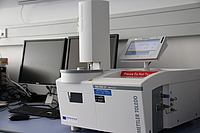
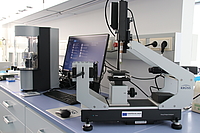
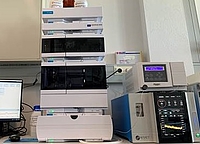
![[Translate to English:] Pulse Duplicator](/fileadmin/_processed_/c/b/csm_GHS-18-0019_Pulse-Duplicator_Herzklappendauertester_a9d797b8e4.jpg)
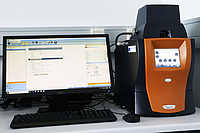
![[Translate to English:] Flash DSC](/fileadmin/_processed_/8/f/csm_EFRE_FlasDSC_Website_6403e09668.jpg)
![[Translate to English:] Electroforce](/fileadmin/_processed_/3/0/csm_EFRE_Electroforce_Website_6df80918a0.jpg)

